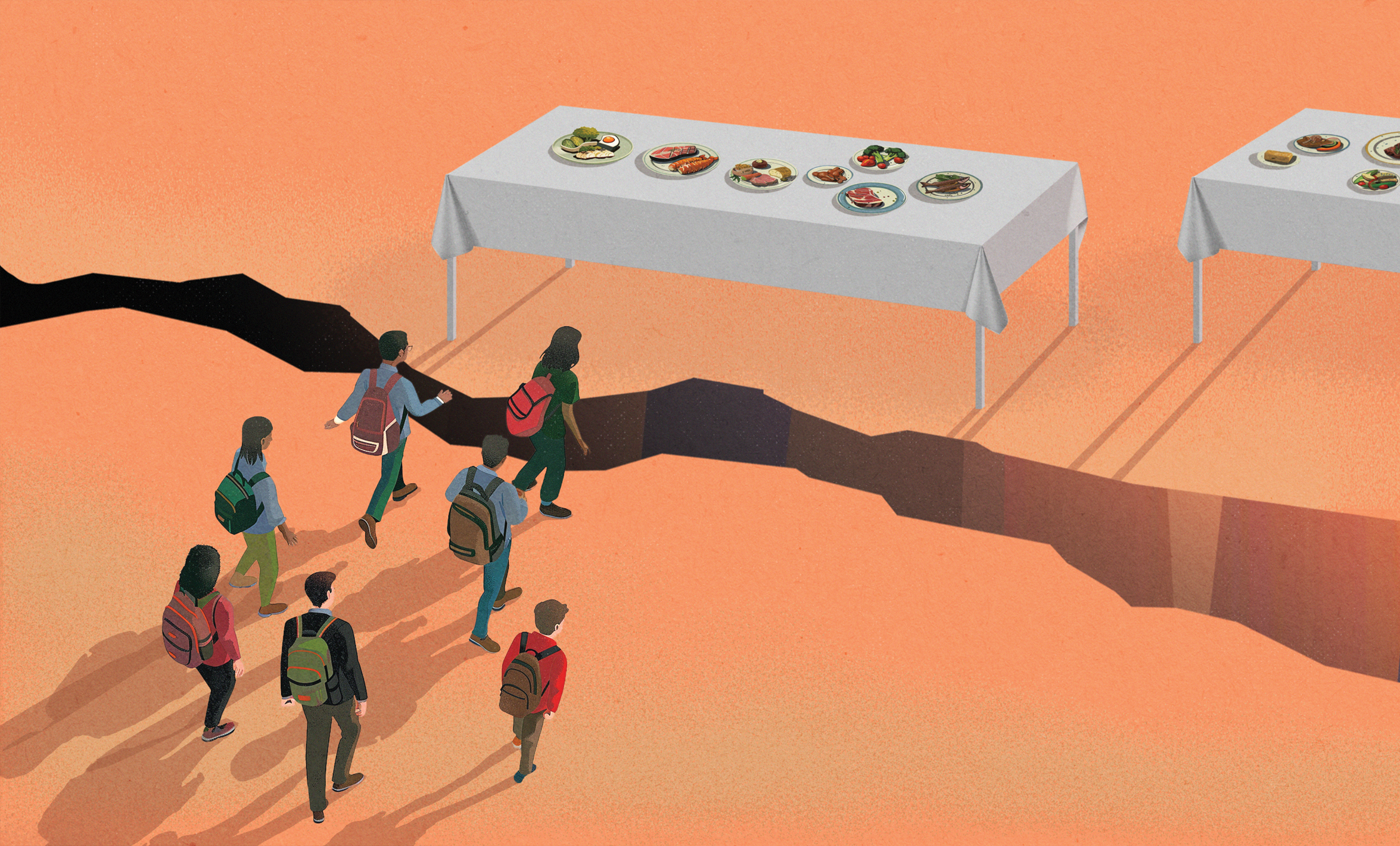The Hunger Gap
Food programs tend to target adults and younger kids. What about adolescents?
When Kate was about 13 years old, her mother had just gone through a divorce and was struggling financially. They lived in a neighborhood with 7-Elevens and dollar stores, but no grocery stores. When she was hungry before her mother came home late from work, she had to make do with whatever she could find. Kate didn’t know how to cook beyond using a microwave.
“That wasn’t always nutritious,” says Kate, now a 19-year-old college sophomore. “Noodles all the time is not healthy for anyone. Eating just snacks is not healthy.”
Kate’s experience with food insecurity—not having enough food or enough high-quality food to meet one’s nutritional needs—is not uncommon in America. In 2021, 10% of Americans and nearly 13% of children were food insecure, according to Feeding America, a nationwide network of food pantries and meal programs. In Baltimore, the issue was even more pronounced, with 14% of residents and 26% of children experiencing food insecurity.
Not having enough food takes a particularly heavy toll on adolescents, who need more calories than younger children to support their rapid physical, emotional, and social development, says Kristin Mmari, DrPH, MA, an associate professor in Population, Family and Reproductive Health. Food insecurity may also be more prevalent among adolescents than younger children: A 2018 study in European Economic Review of 1,600 low-income U.S. households, for example, found that when a family is food insecure, younger children are prioritized and adolescents often go without.
A longtime adolescent health researcher, Mmari started studying food insecurity after seeing a 2016 Urban Institute report showing that food-insecure adolescents were taking serious risks to get food, including shoplifting and stealing. In some communities, teens tried to get arrested or fail out of school knowing they would be fed in jail and in remedial education programs.
“If adolescents are food insecure, they’re hardly able to learn,” Mmari says. “All kinds of linkages with different health outcomes and particularly mental health have been shown.”
The solution seemed simple: Make sure teens and young adults have access to food. But first policymakers needed to see this hidden hunger and then get on board with programs to address it.
In 2018, Mmari and PFRH colleagues Asari Offiong, Susan Gross, and Tamar Mendelson conducted a qualitative study to understand food insecurity among urban adolescents and identify potential community-based interventions to address it. To involve teens in the study, Mmari collaborated with Joni Holifield, founder of HeartSmiles, a nonprofit that provides mentorship and leadership training for disadvantaged Baltimore teens and is affiliated with the Johns Hopkins Center for Adolescent Health.
The resulting 2019 Public Health Nutrition article found that almost half of the 53 participants were food insecure, and 13% reported not eating for a whole day because their family lacked money for food. Many said they were shamed or bullied for needing food—and that they took risks to get it.
“Girls in every single community spoke about it being easier for them to engage in transactional sex than it was for them to go into a food pantry where they were judged,” Mmari says. Boys described stealing, selling drugs, or cleaning car windshields to get money for food.
The teens felt a huge amount of stigma against admitting they were hungry and food insecure, Mmari says. “They said they’d admit almost anything else rather than that, because that was just such an embarrassing thing.”

Adolescents in low-income households are in a challenging spot with food, says Kaitlyn Harper, PhD ’22, MS, MA, an assistant scientist in Environmental Health and Engineering who started volunteering with HeartSmiles in 2018 as a doctoral student.
They are more responsible for obtaining their own food than younger children, but they don’t have a full income or full autonomy. Many Baltimore food pantries are not open when adolescents can access them, or they require a legal ID or that children be accompanied by an adult, she says.
To address the issue among Baltimore youth, several HeartSmiles teens started the Youth Food Security Network (YFSN). In 2021, they came up with a solution: Start an online food pantry. In the first year, the network received $81,000 in funding, and in the second year, $62,000.
To get food from the pantry after its January 2022 launch, young people between ages 14 and 24 filled out an online form with their name, age, address, and contact information, and selected a week’s worth of foods, including fruits and vegetables, starches, and proteins. The Heartbeats, as HeartSmiles teens are known, entered the information into Instacart, which delivered the food directly to the young clients. The pantry grew dramatically as word got out, and in 2023 it served just under a thousand weeks of meals to clients, Harper says.
One of those clients was Kayla Mayfield, 19, a former YFSN member and then a first-year nursing student at Bowie State University. Before the program, she’d order fast food because it was the most convenient and inexpensive, but she knew it wasn’t nutritious.
“Once I started using the pantry, I started to meal prep,” she says. “I would order my vegetables, like green beans and broccoli, and my favorite protein, the pepper steak.”
Mayfield found the service so helpful, she recommended it to several college friends, who also used it.
At the end of February 2024, the online pantry ran out of funding. Harper and HeartSmiles are now looking to develop a more financially sustainable model and for partners to help them.
Another of the group’s projects is still running but also struggles to keep up with demand. The Granny Project began in 2020 and operates as a cooking show, with an older community member providing video instruction on how to cook a meal, while young people cook along at home with food provided by HeartSmiles. Dishes have included shrimp alfredo, pizza, and chicken breasts baked with broccoli. Before each week’s session, Heartbeats help with purchasing, packaging, and transporting food for the week’s meal to up to 25 families who have signed up.
Every week, more people try to register than the project has funds for.
Mmari, Holifield, and Harper know the work they’ve done so far is only a partial solution. They constantly ask young people for ideas. They’ve advised that food should be combined with other services to decrease stigma, including job training, employment programs, and training teens how to grow food in a community garden. Offering food with programs is something HeartSmiles has long done, Holifield says.
“Heartbeats frequently invite family and friends to our programs because they know they will get to eat,” she says. “It’s such a huge driver and factor because too many times we might be the only option a young person has for obtaining a meal they actually want to eat.” Yet finding the funds for this food is one of her biggest challenges because funders don’t understand why food is so important, she says.
Policymakers also tend to overlook adolescents when they consider this issue. “When we talk about food assistance programs, we typically think of families with younger children,” Mmari says. “But we don’t associate adolescents with food insecurity.”
Mmari has studied food assistance policies to understand both their effectiveness and how they can better serve adolescents. She and Harper studied Baltimore teens whose families received Supplemental Nutrition Assistance Program (SNAP), Summer SNAP, and P-EBT during COVID. The results, published in 2023 in the American Journal of Public Health, showed that none of the programs made a measurable difference in adolescent food insecurity.
One reason may be that SNAP benefits are tied to the U.S. Department of Agriculture’s Thrifty Food Plan, Mmari explains. The plan is based on a family of four: a man and a woman ages 20–60, a child age 6–8, and another child age 9–11. Adolescents’ higher calorie needs are not considered. SNAP benefits also go to the head of the household, not the teen, although teens may be at least partly responsible for getting their own food.
The program could be modified to better serve adolescents, says Mmari, who has applied for an internal grant through the Bloomberg American Health Initiative to keep studying the issue. A pilot project she’s considering would give adolescents an Instacart card with the money equivalent to SNAP benefits.
“Would adolescents use these benefits? How would they use them? How long would they last? We don’t know the answers to these questions yet,” she says.
Partnerships across sectors will be essential to solving the problem, Mmari says. Examples could include connecting youth employment opportunities with food assistance programs or developing a culinary school or community garden project for teens.
“There are a variety of different ways to form multisectoral partnerships on this issue, but we often silo each of these sectors, which creates more barriers for addressing adolescent food insecurity,” she says.
